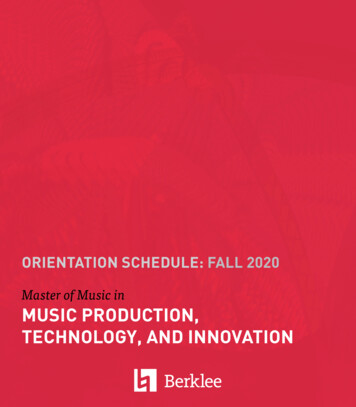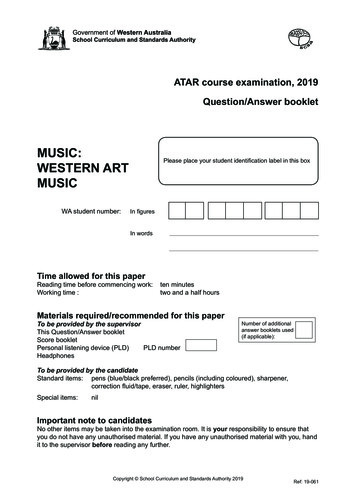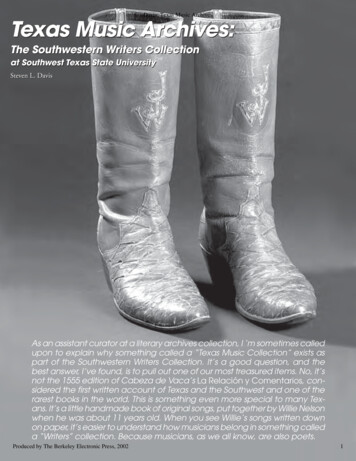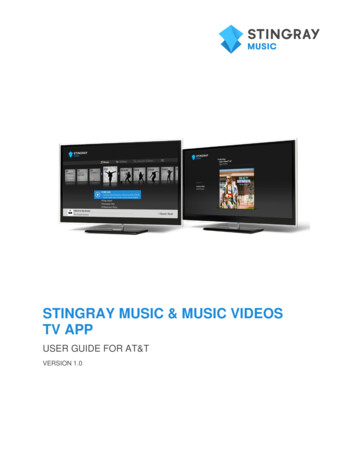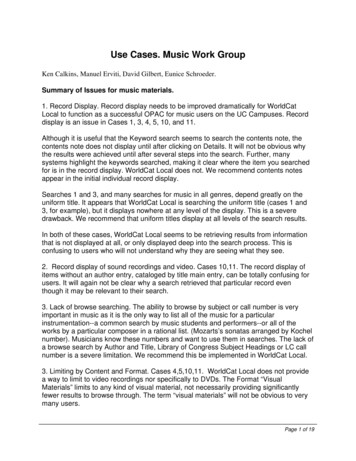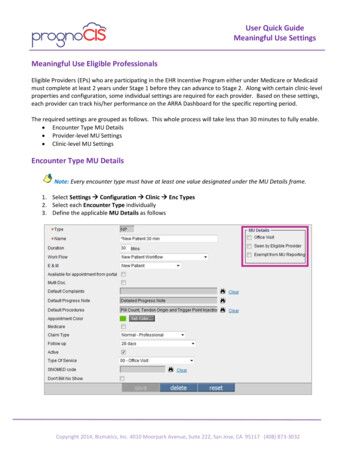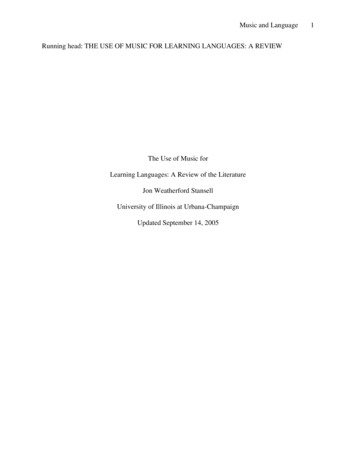
Transcription
Music and LanguageRunning head: THE USE OF MUSIC FOR LEARNING LANGUAGES: A REVIEWThe Use of Music forLearning Languages: A Review of the LiteratureJon Weatherford StansellUniversity of Illinois at Urbana-ChampaignUpdated September 14, 20051
Music and Language2AbstractThroughout time, healers, philosophers, scientists, and teachers have recognized the place ofmusic for therapeutic and developmental functions (Bancroft 3-7). Researchers over the lasttwenty years have made astounding advances in the theory of language acquisition. Many findthe pedagogical conjoining of language and music compelling. The first part of this reviewfocuses on the historical and developmental proofs of music's relationship with languagelearning. In part two, neurological theory on music and the mind are covered. Part threesummarizes scholarly inquiry on the use of music for learning languages, especially those studiesthat could prove most instructive both for language teachers and for music therapists in thedevelopment of curricula.
Music and Language3The Use of Music forLearning Languages: A Review of the LiteratureDescribed in the earliest cultural records, enacted throughout the development of infants,evidenced from cognitive scientists, and utilized by innovative teachers and therapists, the deepand profound relationship between music and language supports their discriminate, concurrentuse to improve outcomes for language acquisition. Melodic recognition, contour processing,timbre discrimination, rhythm, tonality, prediction, and perception of the sight, sound, and formof symbols in context are required in both music and language. Like supportive sisters, theycomprise "separate, though complimentary systems of structured communication. languageprimarily responsible for content and music evoking emotion” (Jourdain 293). Music positivelyaffects language accent, memory, and grammar as well as mood, enjoyment, and motivation.Language teachers and music therapists alike should encourage the conjoined study of thesenatural partners, because communicating through a musical medium benefits everyone.Music Pervades Life: Therapy, Development, and LearningThroughout time and in all areas of the world, music‟s universal presence asserts itsimportance. W. Jane Bancroft presents an impressive litany of historical music therapists,including tribal shamans, Egyptian priest-physicians, the biblical David, Pythagoras, Aristotle,and Plato (Bancroft 4-5). She asserts, "In every part of the ancient world, music and musicalinstruments served magical or 'therapeutic' purposes rather than aesthetic ones” (Bancroft 4).Plato believed that "musical training is a more potent instrument than any other, because rhythmand harmony find their way into the inward places of the soul, on which they mightily fasten.making the soul of him who is rightly educated graceful” (Jowett 271). He took the concept ofphysical healing a step further, in the holistic manner common to the Greeks, advocating the
Music and Language4learning outcome of correct education as a graceful soul. As if bringing grace to the soul was notenough, music also embraced language and movement.In The Greek View of Life, G. Lowes Dickinson defines mousikas, from which our word"music" derives, as an "intimate union of melody, verse, and dance” (217). The Greek concept ofmousikas was much more inclusive than ours. Music implied language, Plato himself consideringa tune without words a "sign of a want of true artistic taste." Language uniquely enabled theGreek listener "to distinguish the exact character of the mood which the rhythm and tune issupposed to represent” (Dickinson 217). Plato expected language in a musical context, but he didnot write about the music inside language. For insight into this, one must look to the Greekmyths. The word mousikas means "from the muses," and understanding the origins of the musesshows how they understood music's role in the development of linguistic genres.Thomas Bullfinch's Mythology describes the Muses' birth to Mnemosyne, one of the Titans,original rulers of the mythic universe (Bullfinch 22). Mnemosyne's main concern was the humanmemory, a primal dominion as important to the ancient Greeks as the sea and sky. Her daughters,the nine Muses, presided over song and prompted the memory. Seven of these divine beings usedtheir "music" to inspire language, including the spoken genres of epic poetry, lyric poetry, sacredpoetry, love poetry, comedy, tragedy, and history (Bullfinch 22). The eighth focused on, of allthings, astronomy, and the last Muse did something different; through her "music," mortalsbecame inspired not only to choral song but also to dance (Bullfinch 22). Each originating fromthese sisters of inspiration, the arts of poetry, tragedy, song, and dance comprised the classicGreek theatre. With music and language, the drama and dance of life can occur. The section onhuman development that follows will echo this powerful metaphor as it discusses the dualprocesses of language and music learning.
Music and Language5W. Jane Bancroft references Apollo and Dionysus, both of whom used music. These two,one the wise physician to the gods, and other a sensual corruptor of mortals, represent themodern therapeutic uses of music either "to assuage and soothe" or "to arouse and energize”(Bancroft 4). Music therapists utilize both types of music in clinical situations to relieve manykinds of psychological and physical stressors. Linguistic inadequacies resulting from trauma ordelay often benefit from music therapy. Likewise, language students that lack familiarity with atarget culture and have trouble expressing themselves can connect through the freeing influenceof music. In these cases, the goals of the teacher closely resonate with those of the musictherapist.Meaningful communication is a multimodal construct, a large part of which is musical.Spanish music therapist Patxi Del Campo (1997) asserts, “In any oral interaction only 15% of theinformation corresponds to verbal language, while 70% of the message is performed throughbody language; the final 15% belongs to intonation, the musical character of language” (as citedin Mora, p.147). Although this ratio likely varies depending on the exact nature of the languagetask, interlocutors, and intentions, by drawing oral interaction in such a light, Del Campo evokesthe three classical elements of mousikas, melody (intonation), verse (words), and dance (bodylanguage). This suggests that face-to-face interaction is as much a musical call-and-response asan exchange of words. Moreover, it could be more precise to classify it as a type of dance withmusical and linguistic aspects that add expressive or concrete details.The elements of movement, language, and song are also developmentally connected. Dr.Alfred Tomatis asserted that the ear's integration of information from sound and motormovements is crucial to the early nervous system. From aural input, an infant develops not onlysound perception, location, and discrimination, but also the physical movements of verticality
Music and Language6and laterality, as well as language. Dr. Tomatis also described fetal and infant orientation to themelody contours of their native language, recognizing the mother's voice (as cited in Thompsonand Andrews, 181-182).The pre-existing patterns of music in the early development of language prove that the twoare already long acquainted. Through its mother's body, womb, and amniotic fluid, a fetus cannothear consonants; it only hears the musical vowel sounds. Carmen F. Mora claims,Discourse intonation, the ordering of pitched sounds made by a human voice, is thefirst thing we learn when we are acquiring a language. Later on, it is throughinteraction that a child picks up not only the musicality of each language, but also thenecessary communication skills. Mora 149Mora asserts that a child can imitate the rhythm and musical contours of the language longbefore he can say the words, and caretakers of young children will agree. She says that musicalaspects of language, tone, pauses, stress, and timbre are sonorous units into which phonemes, theconsonant and vowel sounds of language, are later placed (Mora 149).Joanne Loewy proposes that language should be considered not in a cognitive context, but ina musical one, which she calls the Musical Stages of Speech (Loewy 48). It evolved from thework of Charles Van Riper, a founder of modern speech therapy. Infants begin with 1) cryingand comfort utterances, proceed to 2) babbling, and eventually begin 3) acquiring/comprehending words. All of these sounds developmentally prepare for the telegraphic speechthat follows (Van Riper 87). Loewy's model specifies the mental, physical, and emotionaldevelopments at each level and offers specific techniques to encourage vocalizing (Loewy 49).Instead of thinking about language development from the first words, caretakers can follow achild's orientation to communication from the first utterances. Physicians can tell if an infant willhave problems with speech by testing their production of cooing sounds, which are a precursor to
Music and Language7and predictor of speech (Loewy 52). Prelinguistically, music serves as the carrier forcommunicative intent.The intonation contours within crying and babbling behavior have an emergingcommunicative purpose. These are the infant's "first audible expression of emotional need"(Loewy 51). Because there are no words involved, all of this communication comes through themusical elements of the cry. Loewy asserts that adults who wish to comfort children can sing in achild‟s tonality, modeling notes that resolve dissonant notes of distress (Loewy 53). Use ofdrums to encourage internal rhythm is also helpful (Loewy 55). An infant's preverbalcommunication through crying incorporates turn taking, pausing when her needs are met, andthis builds a foundation for social interaction with peers (Loewy 67).With a solid background in crying, most infants soon move to babbling, which enables themto consciously experiment with prosodic elements of speech, such as tone, pauses, timbre, andstress. Loewy asserts, "This music of speech is the earliest dimension of language that is usedand understood by children” (Loewy 61). The babble introduces words with consonant – vowel –consonant constructions and semantic placement in musical phrases. These phrases become partof the dance of caregiver-child interaction. True words and sentences are only a few steps away.Whereas babble can be represented with letters, the meaning of this new linguistic production isstill carried by the vocal contours. No wonder, then, when an adult wants to infantilize a peerwho complains too much, he will match the exact musical contour of that person‟s speech,exaggerate the prosody, and simplify the phonemes. Thus, "But I wanted diet, not regular!"becomes "Ba wa-wa daya na wewuwa!" He shows an intuitive understanding that the musiccarries similar content on a less complex level of linguistic sophistication. These examplesindicate that music and language are intricately interwoven.
Music and Language8Chen-Hafteck adopts a similar stance and draws together developmental research in musicand language to support this position. She asserts, "Music and language are the two ways thathumans communicate and express themselves through sound. Since birth, babies start to listenand produce sound without distinguishing between music and language, singing and speech”(Chen-Hafteck 85). Infants can distinguish meaningful sounds from background noises. Theynotice the sound qualities of direction, frequency, intensity, duration, tempo, intonation, pitch,and rhythm (Chen-Hafteck 86). The musical and language systems both grow from this commonsource. For this reason, it is difficult to describe which utterances are pre-musical and which arepre-linguistic. As evidence of the close relationship between these two communicative systems,note the process that occurs when a person begins to weep while talking. Prosodic features of aircontrol, pacing, tone, and tenor become more exaggerated and emotions break through inmusical representations while language retreats into babbling.This section concludes with the affirmation that the importance of music in therapy,growing, and teaching is supported by our cultural heritage and childhood developmentsequences. Language teachers and music therapists should collaborate on their joint venture, asthe literature shows that they have much to offer each other, and they seem to be talking aboutthe same thing, essentially. The seemingly important distinctions between a therapist‟s affectiveor healing outcomes and a teacher‟s cognitive or learning outcomes become less useful inpractice, especially in a developmental context, because the proper functioning of the mind isdependent upon holistic wellness. In well-developed treatment scenarios, a music therapistcollaborates with educators or language pathologists, but language teachers seldom if ever hearthe therapist's perspective. The focus of this review will now change, for the time being, awayfrom the historical and developmental proofs of music‟s place with language learning, and
Music and Language9towards neurological evidence of music‟s effect on the mind. Modern studies show how themind develops musical aptitudes, and how intelligence research has revolutionized teaching.Music and the MindAlthough the previous section has shown a close connection between music and language,discrete intelligences govern these two systems, which oversee different types of information.Though intelligence as a single construct began to be discounted in testing situations prior to1983, in that year, Howard Gardner proposed that IQ be replaced by MI, or MultipleIntelligences. The candidates for intelligence status had to meet the following eight criteria:1) Potential isolation by brain damage; 2) The existence of idiot
14.09.2005 · first thing we learn when we are acquiring a language . Later on, it is through interaction that a child picks up not only the musicality of each language, but also the necessary communication skil ls. Mora 149 Mora asserts that a child can imitate the rhythm and musical contours of the language long



